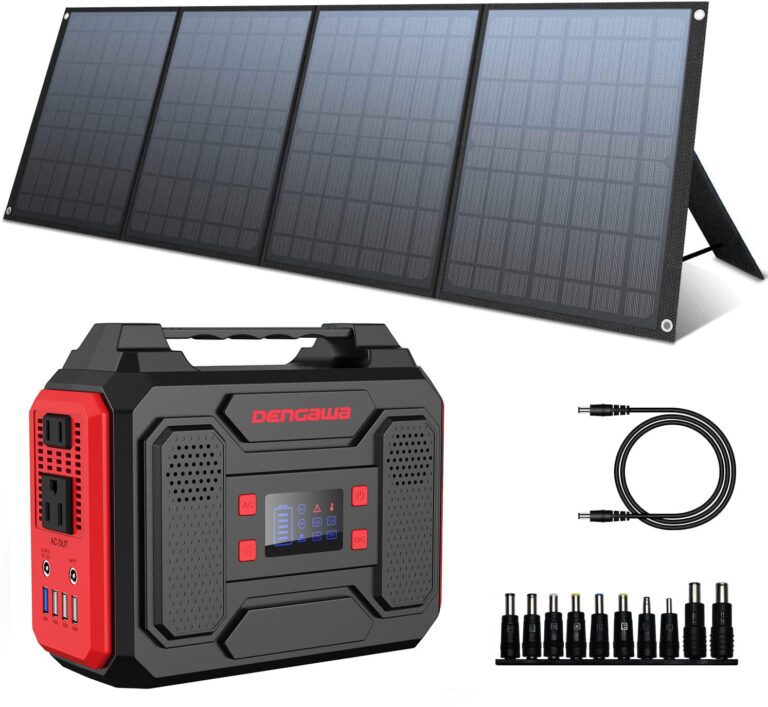Traveling in an RV offers the freedom to explore and enjoy nature, while still providing the comforts of home. One key aspect of maintaining those comforts is having a reliable power source. Solar energy has emerged as an eco-friendly and sustainable way to keep your RV’s battery bank charged. Utilizing a solar battery bank allows you to harness the power of the sun efficiently and can save money on fuel or campsite electricity fees in the long run.
RV solar battery banks are specifically designed to store energy generated from solar panels, which can then be used to power electrical appliances and devices inside your RV. Not only is this a clean and renewable energy source, but it also allows for greater independence from relying on traditional power systems.
When selecting an RV solar battery bank, it’s essential to consider several factors such as battery capacity, type, and compatibility with your existing solar setup. Understanding your power needs and consumption patterns will help you choose the right battery size and type, ensuring a smooth experience for your off-grid adventure. It’s also necessary to ensure that the battery bank you choose is compatible with your solar panels’ output and your RV’s electrical system.
In this article, we’ll guide you through the process of finding the perfect RV solar battery bank to meet your needs, and ensure you have all the information necessary to make an informed decision. Choosing the right device can significantly enhance your RV experience, giving you the freedom to fully enjoy your time on the road.
Best RV Solar Battery Banks
Are you tired of constantly recharging your RV’s battery? Fear not, we’ve got you covered! Check out our top picks for the best RV solar battery banks below. These solar-powered solutions are here to make your outdoor adventures more worry-free and enjoyable, without the hassle of a dead battery!
DenGaWa 250W Portable Power Station with 40W Solar Panel
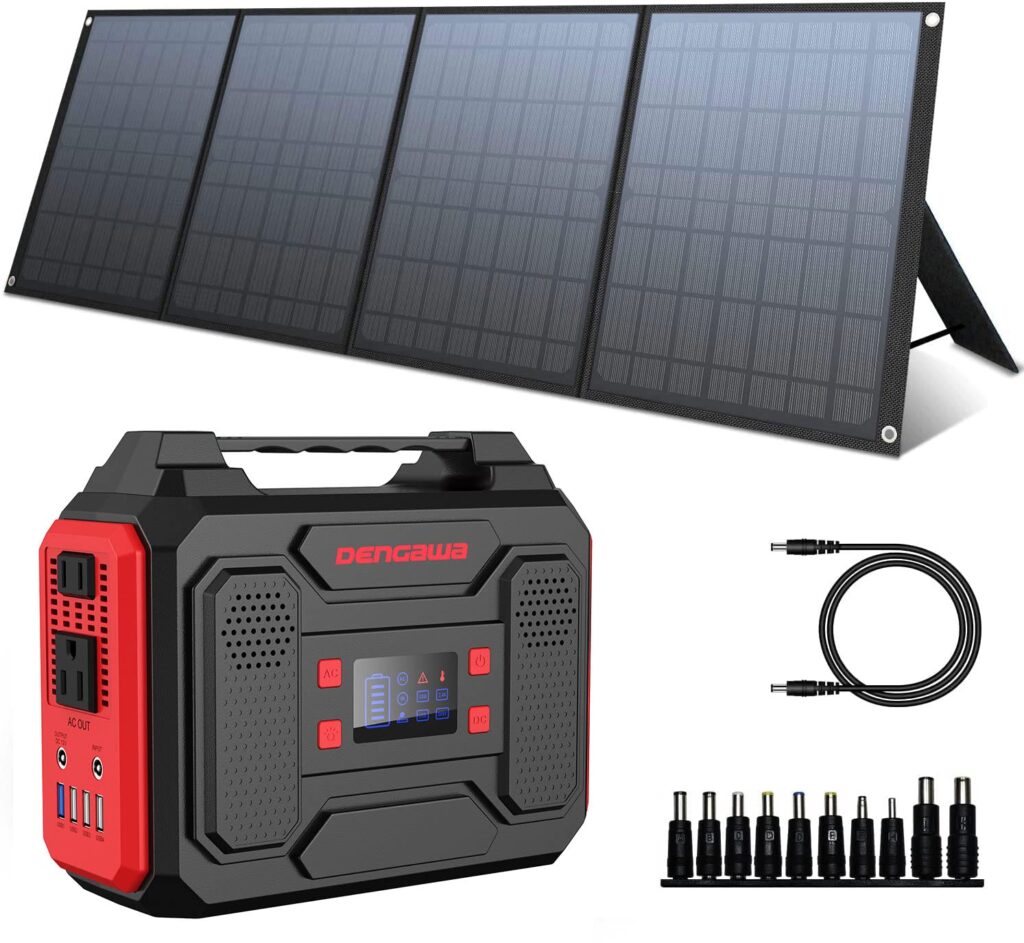
The DenGaWa 250W Portable Power Station with 40W Solar Panel is a reliable and convenient choice for those seeking a solar battery bank for their RV.
Pros
- Portable and easy to carry
- Multiple charging outputs for versatile use
- High-capacity battery for extended usage
Cons
- May take a long time to charge with solar panel
- Limited to powering devices under 250W
- Not suitable for heavy-duty appliances
The DenGaWa 250W Portable Power Station with a 40W Solar Panel is designed with portability and convenience in mind. It’s foldable and travel-friendly, making it an ideal choice for outdoor enthusiasts who want to power their RV appliances and devices. The solar panel’s 22% high conversion efficiency ensures you can harness solar energy effectively during your adventures.
Space-saving and easy to carry, this 67,500mAh (250Wh, 3.7V) solar power bank can power a range of devices, including laptops, phones, fans, and cameras. With seven output options, including two AC outlets, a DC output port, three USB output ports, a USB QC 3.0, and a cigarette lighter, you’ll never run out of charging options.
Apart from its large capacity, the power station’s 40W solar panel is designed with two output ports, a DC output (15V, 2.6A Max), and a USB QC3.0. The TIR-C technology helps maximize charging speed, while protecting your devices from overcharging or overloading.
Although the DenGaWa 250W Portable Power Station’s solar panel takes around 8-10 hours to charge, placing it in direct sunlight all day will provide ample power for your devices, even lasting through the night. However, due to its 250W wattage limit, it’s not suitable for running heavy-duty appliances.
In conclusion, the DenGaWa 250W Portable Power Station with 40W Solar Panel is a handy and reliable solar battery bank for RV users looking for a portable and convenient power source during their outdoor adventures.
Apowking 500W Portable Power Bank
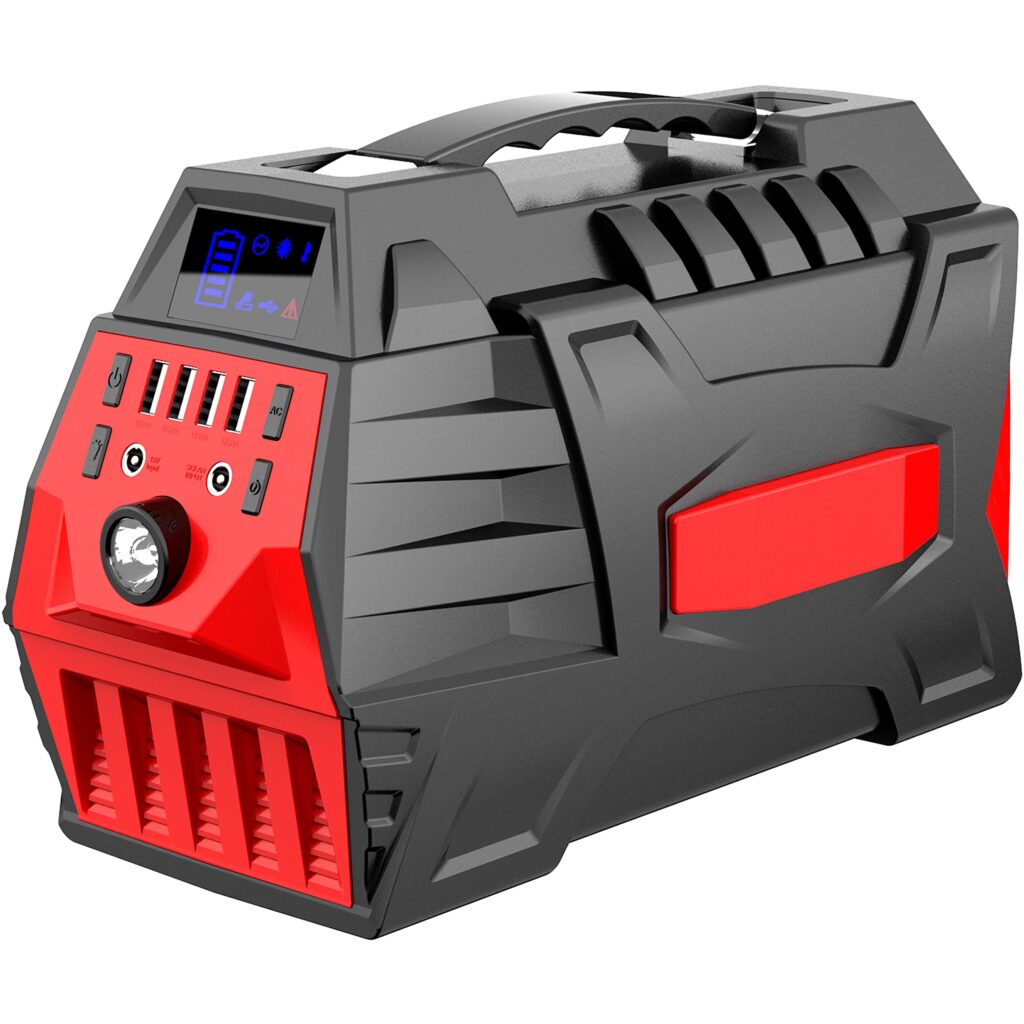
This Apowking 500W Portable Power Bank offers an impressive versatility for all your charging needs during outdoor trips and power outages.
Pros
- High 296Wh (80,000mAh) capacity
- Multiple output options: AC, USB, and DC
- Three recharging methods, including solar
Cons
- Solar panel not included
- 500W output power limit
- Recommended use with heating products below 200W
The Apowking 500W Portable Power Bank is an excellent companion for outdoor enthusiasts and those who often experience power outages. Its high 296Wh (80,000mAh) capacity can power various devices, such as phones, laptops, tablets, lights, and even small appliances like a car refrigerator, contributing to its wide range of uses.
With multiple output options like two pure sine wave AC output ports, four QC USB ports, and one DC vehicle output port, it can adequately cater to most of your charging needs on the go. Moreover, the built-in cooling fan ensures the battery pack remains cool even during extended use, automatically activating when needed to avoid overheating.
One major advantage of this portable power bank is its ability to recharge through three different methods. Besides the usual wall outlet and car outlet, it can also be recharged using solar energy (DC 13-23V, 40-120W), making it an eco-friendly choice when on outdoor adventures. However, it’s important to note that a solar panel is not included and must be purchased separately.
A few limitations to keep in mind include its 500W output power limit, meaning it cannot handle devices consuming more power than that. Additionally, it’s recommended not to use heating products with wattages over 200W. However, with its impressive range of features, portability, and high capacity, the Apowking 500W Portable Power Bank is an excellent investment for anyone who needs reliable power on the go.
ACOPOWER 200W MPPT Solar RV Kit
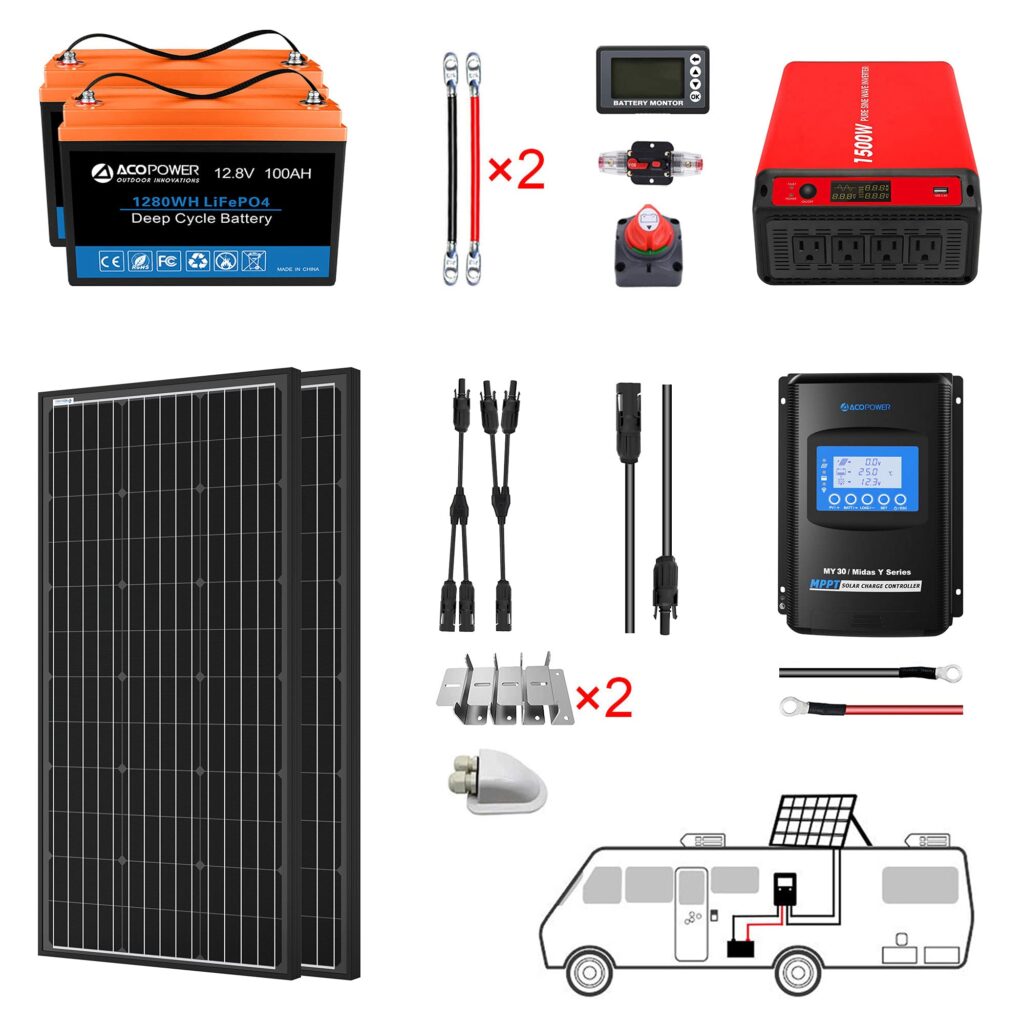
Transform your RV life with this versatile and efficient solar battery bank setup.
Pros
- 1500W pure sine wave inverter for reliable AC power
- High-capacity 2560Wh Li-batteries with 3000+ deep cycles
- Comprehensive kit includes all necessary parts for easy DIY installation
Cons
- Highly dependent on sunlight availability
- May not support very high electrical demands
- No real-world experience with product
ACOPOWER’s 200W MPPT Solar RV Kit has everything you need to start your off-grid solar journey. The monocrystalline solar panels and the MPPT charge controller ensure high efficiency charging for your 12V lithium battery bank. This saves you from the hassle of searching for compatible items, as all the required accessories are included in one convenient package.
At the core of this kit are the two 100Ah LiFePO4 batteries, offering a combined 2560Wh power capacity. Their high charging/discharging efficiency and 3000+ deep cycle lifespan outshine traditional lead-acid batteries. Plus, the built-in 100A BMS (Battery Management System) with the MPPT controller ensures your battery bank stays protected at all times.
Whether you’re using the solar panels for an RV, cabin, boat, or remote power system, the kit covers all your needs. With moderate use, you can expect to receive approximately 960Wh (or 80Ah) of charge per day. However, keep in mind that these figures rely heavily on available sunlight, so your mileage may vary depending on location and weather conditions.
In conclusion, the ACOPOWER 200W MPPT Solar RV Kit presents an all-in-one solution for those looking to add solar energy to their off-grid setup. Its comprehensive package, high-capacity Li-batteries, and user-friendly DIY installation make it a solid choice for travelers. Just be prepared for fluctuating power generation due to sunlight availability, and know that this kit might not support heavily demanding electrical systems.
Apowking 146Wh Portable Power Bank with AC Outlet & 40W Foldable Solar Panel
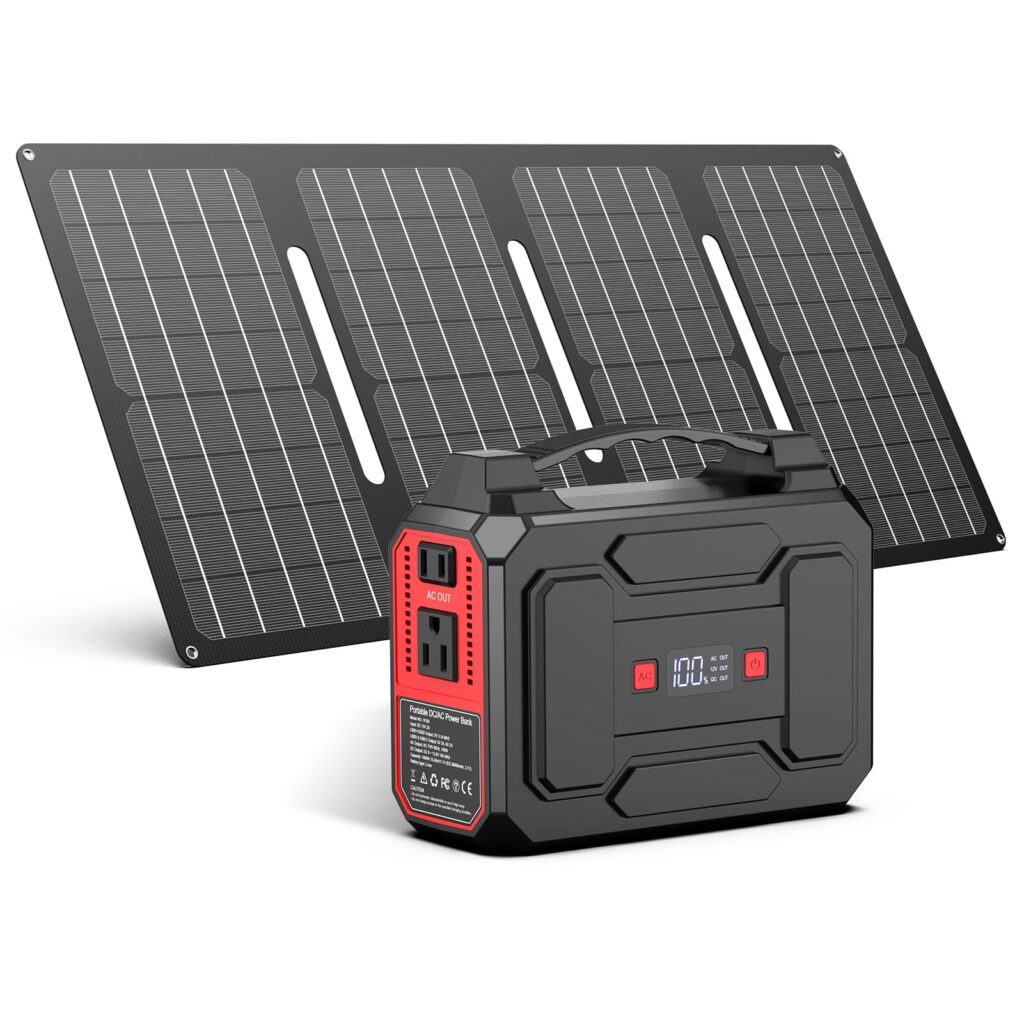
A versatile, budget-friendly option for outdoor enthusiasts seeking solar-powered charging solutions.
Pros
- High-capacity battery with 146Wh/39600mAh lithium-ion battery pack
- Multiple output options for charging various devices
- Included 40W foldable solar panel for convenient, eco-friendly charging
Cons
- Some quality consistency issues from user reviews
- Not suitable for powering high energy consumption appliances
- Junction box not waterproof, so extra care needed to keep it dry
The Apowking 146Wh Portable Power Bank is ideal for those who need a reliable solar battery bank for their RV trips, camping adventures, or as a backup power source at home. This portable power station features both AC and DC outlets to charge laptops, phones, tablets, cameras, fans and more. The 40W foldable solar panel included in the kit is lightweight and easy to set up, allowing you to harness the sun’s energy while enjoying the great outdoors.
One of the most significant advantages of the Apowking solar battery bank is its versatility. It offers a variety of output options, including two AC outlets, USB ports with fast charging capability, and a DC 12V output. This means that the power bank can accommodate a wide range of devices, making it useful in multiple situations.
However, it’s important to note that some users have reported quality inconsistencies with their Apowking power banks, which may detract from the overall experience. Additionally, although the main-board is designed with IPX4 waterproof materials, the junction box is not waterproof, so extra care should be taken to keep it dry.
In summary, the Apowking 146Wh Portable Power Bank offers a budget-friendly, versatile charging solution that can make camping or other outdoor adventures safer and more convenient. With its high-capacity battery, multiple output options, and eco-friendly solar panel, this power station is a solid choice for those seeking a portable solar battery bank for their RV or outdoor activities.
Buying Guide
As we venture into the world of RV solar battery banks, it’s crucial to know what to look for and how to choose the best product for our needs. Let’s dive into some key features to consider while deciding which solar battery bank is right for us.
Capacity
First and foremost, we need to consider the capacity of the battery bank. This refers to the amount of energy it can store and is usually measured in amp-hours (Ah) or watt-hours (Wh). To determine the ideal capacity, we should calculate our daily energy consumption and then choose a battery bank that can accommodate those needs. Remember that it’s always better to have a little extra capacity than to fall short.
Type of Battery
There are different types of batteries available for solar systems, and choosing the right one is crucial. The most common types are lead-acid, lithium-ion, and AGM (absorbent glass mat). Each type has its advantages and disadvantages, so it’s important to research and understand which one suits our needs the best.
Cycle Life
We should also consider the cycle life of the battery, which is the number of charge and discharge cycles it can handle before its capacity reduces significantly. A higher cycle life means the battery will last longer and provide better value for our investment.
Charging Time
Another factor to consider is the charging time of the solar battery bank. Faster charging times are beneficial, especially when we are relying on solar energy for our RV. This ensures that our battery bank is charged and ready to use, even during shorter periods of sunlight.
Price and Warranty
Of course, the price plays a significant role in our decision-making process. While investing in a solar battery bank, we should also take note of the warranty offered by the manufacturer. A longer warranty signifies better confidence in the product and provides us peace of mind in case of any issues down the line.
By keeping these factors in mind, we can make an informed decision and select the best solar battery bank for our RV adventures. Happy travels!
Frequently Asked Questions
How can I set up a DIY solar battery bank for my RV?
Setting up a DIY solar battery bank for your RV is easier than you might think. First, you’ll need to determine the power requirements for your RV, which will help you decide on the size and capacity of your solar panels and battery bank. Next, purchase quality solar panels, batteries, and a solar charge controller to ensure the efficient and safe operation of your system. Remember to consider the amount of available space on your RV for installing these components.
To set up the battery bank, connect your batteries in series or parallel, depending on their voltage and capacity. We recommend using deep-cycle batteries designed for solar applications, as they provide a longer lifespan and better performance. Once your batteries are connected, wire them to the solar charge controller, which will regulate the charging process and protect your batteries from overcharging.
Finally, connect your solar panels to the charge controller and secure them on the roof of your RV. Make sure they’re properly angled to maximize sunlight exposure. With the system in place, you can now enjoy the benefits of a renewable energy source, powering your RV’s electrical appliances while reducing your carbon footprint.
Do complete RV solar systems come with batteries?
Complete RV solar systems, also known as plug-and-play or all-in-one systems, typically include solar panels, a solar charge controller, mounting hardware, and wiring. However, they may or may not come with batteries. It’s important to carefully read the product specifications and packaging to determine if the batteries are included.
If the batteries are not included in the package, it’s up to you to select the right battery type, capacity, and voltage for your specific needs. Remember that solar battery systems work best with deep-cycle batteries designed for this purpose. Additionally, make sure your chosen battery is compatible with the solar charge controller provided in the complete solar system kit.
It’s worth noting that purchasing a complete RV solar system can save time and effort compared to assembling your own from individual components. But, keep in mind that you may need to add or upgrade batteries to truly tailored the system to your RV’s power requirements. Overall, investing in a solar system for your RV offers the benefit of clean, renewable energy, reducing your reliance on traditional sources and minimizing your environmental impact.

